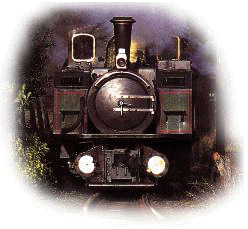

In 1798 a WA Maddock built a Cob, or embankment across the estuary.
The Cob diverted the River Glaslyn, which wore out channel to form the natural
harbour. This harbour was called Port Madoc, known today as Porthmadog.
At the same time, slate mined in the mountains round Blaenau Ffestiniog had to be
taken, first by pack animal to the River
Dwyryd. Then by shallow-draft river boats to the sea, where it was loaded onto ships
Shortly after Maddocks death in 1830, two businessmen, Samuel Holland and Henry Archer promoted an Act of Parliament to construct the Ffestiniog Railway. They surveyed a route down from Ffestiniog to Porthmadog, via the cob. They planned a narrow gauge railway of 23,5 inches, as used in the quarries. The loads would descend under gravity, and horses would pull the wagons back up
The gravity/horse method of use soon came under strain, and the owners of the track looked for a solution using a narrow gauge steam engine. It took until 1863 for contracts to be signed with George England and Co., London, for the manufacture of four small locomotives. The engines were completed in 1864
Soon the railway was under strain again, and obtained permission for a double track in 1869. However this proved to be too expensive, so the railway engineer, Robert Fairlie,was commissioned to build a more powerful locomotive that could get around the sharp curves and up steep gradients in the mountains. His solution was a double-bogie engine.
The double bogie engine looked like two locomotives back-to-back. But it was one
long rigid boiler with central fireboxes Each end of the boiler was mounted on a
swivelling powered bogie. The same principle is used in most of today's diesel and
electric locomotives.
Fairlie's first double bogie engine went into service in 1870, and proved to have more
than double the power of the earlier locomotives. Soon the Railway introduced improved
Fairlie engines.
By the early 1870's coastal sea transport was being overtaken by the network of inland
railways. Standard gauge railways, arrived in Blaenau Ffestiniog. They were able to
take slates away from the aerate without using the Ffestiniog Railway
The popularity of new roofing materials and a series of disastrous strikes hastened the
decline of the slate industry. There was even a new railway, the Welsh Highland, built to
link the former North Wales Narrow-Gauge Railway to the Ffestiniog, thus making a
continuous narrow-gauge route from Dinas (near Caernarfon) to Blaenau Ffestiniog. This
line was opened in 1923 was a failure as it just took too long to make the trip.
Although the line continued to operate during the War, it was closed, nay abandoned in
1946
In 1954, after many difficulties, the Ffestiniog Railway Trust bought the railway. A
wholly volunteer board of directors, enthusiastic volunteers and a small paid staff set
about rebuilding the line to Blaenau Ffestiniog.
Clearance started at Boston Lodge and during the winter of 1954-5 enough track was cleared
to enable the Simplex tractor to run through to Blaenau Ffestiniog. Services were
gradually restored as restoration progressed. By April 1968 Dduallt was reopened.
In 1970 an alternative route to the west of the Tanygrisiau reservoir was agreed and the
Dduallt spiral to raise the line
was completed in 1971. To get to Blaenau Ffestiniog much work had to be done, the
new Moelwyn Tunnel,completed in 1977, which allowed trains to run as far as Llyn Ystradau.
Bridges had to be built over the four power station water pipes to reach Tanygrisiau and
get back on the old track bed. Only one mile of track remained to be restored to bring
trains back to Blaenau Ffestiniog, but there were still many problems.
The rock face just beyond Tanygrisiau was unstable and a serious rock fall demanded
costly remedial action. Eventually on 24 May 1981 came the historic day when, for
the first time since 1957, the track of the Ffestiniog Railway was continuous
from Porthmadog to Glan-y-pwll. the Ffestiniog Railway once again ran from Porthmadog to
Blaenau Ffestiniog.
Costs were reduced, while at the same time the train service was improved by introducing
diesel-hauled trains at off-peak times. The diesel locomotive Conway Castle was built in
Boston Lodge workshops in 1986
Automated signalling at Tan-y-Bwlch and Minffordd passing loops was completed in 1988 and
1989
The Railway is being continually developed to keep it as one of the most successful
tourist attractions in North Wales, run by both volunteers and permanent staff to give
enjoyment to thousands.
You can enjoy gourmet meals on some special Steam & Cuisine trips on the ralway
| Wales Information Wales Calling front page |  |
|
| . | ||
| If you need hotels in Wales Hotel in Wales |  |
Land of mountains and railways - Wales